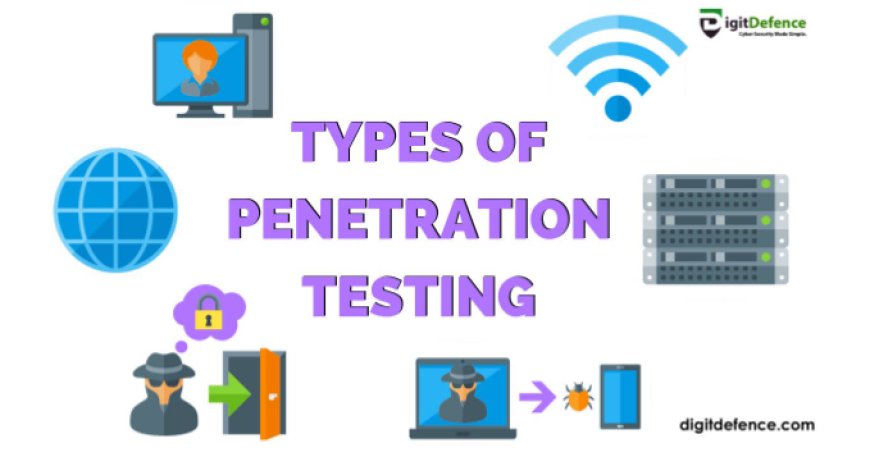Types of penetration testing
Discover different types of penetration testing like Network, Web Application, Wireless, and Social Engineering to boost your cybersecurity.

Penetration testing is the term for a group of techniques used to evaluate the security of physical locations, applications, networks, and computer systems. Using ethical hacking techniques, this proactive method finds weaknesses that criminals could exploit. Penetration testing comes in various forms, such as network, web application, wireless network, social engineering, physical, red team vs. blue team exercises, mobile application, and cloud penetration testing. Its goals are to improve an organization's overall security readiness and reduce potential risks by focusing on particular areas of its IT infrastructure.
Penetration testing can be used in a corporate context to assess the online banking system's security posture of a financial institution. This thorough evaluation uses a variety of testing techniques, such as network, web application, and social engineering penetration tests, to find weaknesses like poor login protocols, SQL injection errors, and phishing attack susceptibility. Data centers and bank branches may also have their security evaluated through physical penetration testing. The complete plan assists the organization in fortifying its defenses, protecting consumer data, and upholding regulatory compliance by duplicating actual cyber threats.
What is penetration testing?
By hiring someone to attempt a break-in, you can employ penetration testing to identify your home's weak points and strengthen them. It assists in locating holes in a business's security measures before actual attackers take advantage of them.
How are penetration tests performed?
-
Planning: Decide what parts of the system to test and set goals.
-
Information Gathering: Gather details about the system like its structure and potential weak points.
-
Finding Vulnerabilities: Look for areas where the system might be vulnerable to attack.
-
Exploiting Vulnerabilities: Test these weak points to see if they can be used to gain unauthorized access.
-
Reporting: Document all the vulnerabilities found and suggest ways to fix them.
-
Fixing Vulnerabilities: Implement the recommended fixes to improve security.
What are the different types of penetration testing?
-
Network Penetration Testing: Assessing the security of network infrastructure, including routers, switches, firewalls, and servers, to uncover vulnerabilities that could be exploited by attackers.
-
Web Application Penetration Testing: Evaluating the security of web applications such as websites, web services, and APIs to identify vulnerabilities like SQL injection, cross-site scripting (XSS), and insecure authentication mechanisms.
-
Wireless Network Penetration Testing: Testing the security of wireless networks and devices to determine if unauthorized access can be gained through techniques like cracking encryption protocols or bypassing access controls.
-
Social Engineering Penetration Testing: Assessing the susceptibility of employees to social engineering attacks such as phishing, pretexting, or impersonation, to identify weaknesses in security awareness and training programs.
-
Physical Penetration Testing: Evaluating the physical security measures of buildings, facilities, and premises through techniques like tailgating, lock picking, or bypassing access controls to gain unauthorized entry.
-
Red Team vs. Blue Team Exercises: Simulating real-world cyberattacks (Red Team) to test an organization's detection and response capabilities, while defenders (Blue Team) respond to these attacks to improve incident response procedures and enhance overall security readiness.
-
Mobile Application Penetration Testing: Assessing the security of mobile applications running on platforms such as iOS and Android to identify vulnerabilities in data storage, communication channels, authentication mechanisms, and runtime environments.
- Cloud Penetration Testing: Testing the security of cloud-based infrastructure, platforms, and services by evaluating configuration settings, access controls, and data protection mechanisms to identify vulnerabilities and misconfigurations.
Challenges in penetration testing
-
Scope Definition: Clearly defining the scope of the test, including what systems and applications will be tested, can be challenging due to the complexity of modern IT environments.
-
Resource Limitations: Penetration testing requires skilled professionals, time, and resources, which may be limited for some organizations.
-
Legal and Compliance Concerns: Ensuring that the testing activities comply with legal and regulatory requirements, such as privacy laws and industry standards, can be challenging.
-
False Positives and Negatives: Distinguishing between genuine vulnerabilities and false positives or negatives requires careful analysis and validation.
-
Impact on Production Systems: Testing activities can potentially disrupt or impact production systems, leading to downtime or performance issues.
-
Complexity of Attack Surface: The increasing complexity of IT infrastructures, including cloud environments, IoT devices, and mobile applications, presents challenges in identifying and assessing all potential attack vectors.
-
Evading Detection: Testers must employ techniques to avoid detection by security monitoring and intrusion detection systems to accurately simulate real-world attack scenarios.
-
Knowledge and Skills Gap: Maintaining a skilled and knowledgeable penetration testing team capable of keeping up with evolving security threats and techniques can be challenging.
Penetration testing, which uses simulated attacks to find weaknesses in systems, apps, and networks, is an important security tool. Although it is very helpful in strengthening security, there are several drawbacks, including issues with scope definition, resource constraints, and legal compliance. It takes careful preparation, experts, and a dedication to staying ahead of emerging dangers to overcome these obstacles. In today's evolving cybersecurity environment, the ultimate goal is to build defenses, secure data, and assure regulatory compliance.































